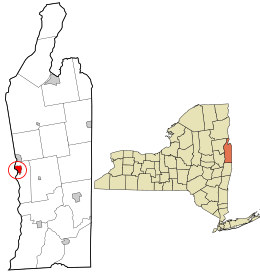Fort Edward (village), New York facts for kids
Quick facts for kids
Fort Edward
|
|
|---|---|
|
Village
|
|

Location in Washington County and the state of New York.
|
|
| Country | United States |
| State | New York |
| County | Washington |
| Area | |
| • Total | 1.91 sq mi (4.96 km2) |
| • Land | 1.76 sq mi (4.56 km2) |
| • Water | 0.15 sq mi (0.39 km2) |
| Elevation | 138 ft (42 m) |
| Population
(2020)
|
|
| • Total | 3,108 |
| • Density | 1,763.90/sq mi (681.14/km2) |
| Time zone | UTC-5 (Eastern (EST)) |
| • Summer (DST) | UTC-4 (EDT) |
| ZIP code |
12828
|
| Area code(s) | 518 |
| FIPS code | 36-26770 |
| GNIS feature ID | 0950467 |
Fort Edward is a small village in Washington County, New York, United States. It is part of the Glens Falls Metropolitan Statistical Area. In 2020, about 3,108 people lived there. The village gets its name from Edward Augustus, Duke of York and Albany. He was the younger brother of King George III.
The village is part of the larger town of Fort Edward. The county seat of Washington County is just north of the village.
Contents
History
Early History of Fort Edward
Fort Edward, also known as "The Fort," has always been an important place. It controls the areas around the Hudson River and Champlain River. At this point, the Hudson River has waterfalls and rapids. So, boats cannot travel further north.
Long ago, travelers would leave the Hudson River at Fort Edward. They would carry their canoes overland to Lake George. Native Americans called this area Wahcoloosencoochaleva. This means "The Great Carrying Place." Fort Edward was the most northern point on the Hudson River for early Dutch settlers. It was also near the border between the Province of New York and New France.
Building the Forts
As early as 1709, during Queen Anne's War, a wooden fence (called a stockade) was built here. It was named Fort Nicholson. About 450 soldiers guarded it. They built a simple stockade to protect their supplies and log huts.
Later, in 1731, the fort was rebuilt as Fort Lydius. This was a trading post for a fur trader named John Lydius. In 1755, during the French and Indian War, it was rebuilt again as Fort Lyman. However, Sir William Johnson renamed it Fort Edward that same year. A large military base was also built on nearby Roger's Island. Today, this site is a special historical place. Another smaller fort was built across the Hudson River.
During the American Revolution, British forces took control of the area in 1777. This was under the command of John Burgoyne.
Fort Edward After the Revolution
In 1823, the Champlain Canal was finished. This canal connected areas to the north and south. It replaced an older, smaller canal that helped boats get around the local rapids.
The village of Fort Edward officially became its own separate village in 1849. It separated from the larger town of Fort Edward.
The Old Fort House Museum
The Old Fort House Museum is a great place to visit. It is located on Lower Broadway in the village. The Fort Edward Historical Association runs it. This museum campus includes:
- The Old Fort House, built in 1772. It was made from wood taken from the old Fort Edward.
- An old Plank Road Tollhouse from the 1840s.
- A law office from 1853. A judge from Washington County used to work there.
- The Riverside Schoolhouse, which has only one room.
- The Cronkhite Pavilion, which shows Native American, military, and local history.
- The Fort Edward Water Works Barn, with exhibits on old transportation and farming.
Geography
Fort Edward village covers about 1.9 square miles (5.0 km²). Most of this area is land, about 1.8 square miles (4.6 km²). A small part, about 0.1 square miles (0.4 km²), is water.
New York Route 197 meets U.S. Route 4 in Fort Edward. The Champlain Canal also connects to the Hudson River south of the village.
Fort Edward is across the Hudson River from the town of Moreau. Moreau is in Saratoga County.
Population Information
| Historical population | |||
|---|---|---|---|
| Census | Pop. | %± | |
| 1870 | 3,492 | — | |
| 1900 | 3,521 | — | |
| 1910 | 3,762 | 6.8% | |
| 1920 | 3,871 | 2.9% | |
| 1930 | 3,850 | −0.5% | |
| 1940 | 3,620 | −6.0% | |
| 1950 | 3,797 | 4.9% | |
| 1960 | 3,737 | −1.6% | |
| 1970 | 3,733 | −0.1% | |
| 1980 | 3,561 | −4.6% | |
| 1990 | 3,561 | 0.0% | |
| 2000 | 3,141 | −11.8% | |
| 2010 | 3,375 | 7.4% | |
| 2020 | 3,108 | −7.9% | |
| U.S. Decennial Census | |||
The table above shows how the population of Fort Edward has changed over the years. In 2000, there were 3,141 people living in the village. There were 1,247 households, which are groups of people living together.
See also
 In Spanish: Fort Edward (villa) para niños
In Spanish: Fort Edward (villa) para niños

